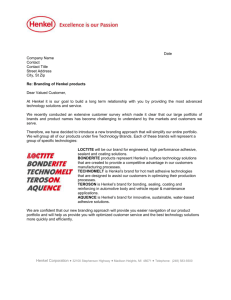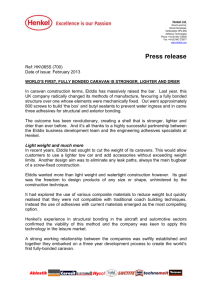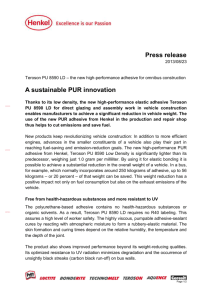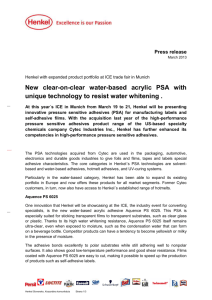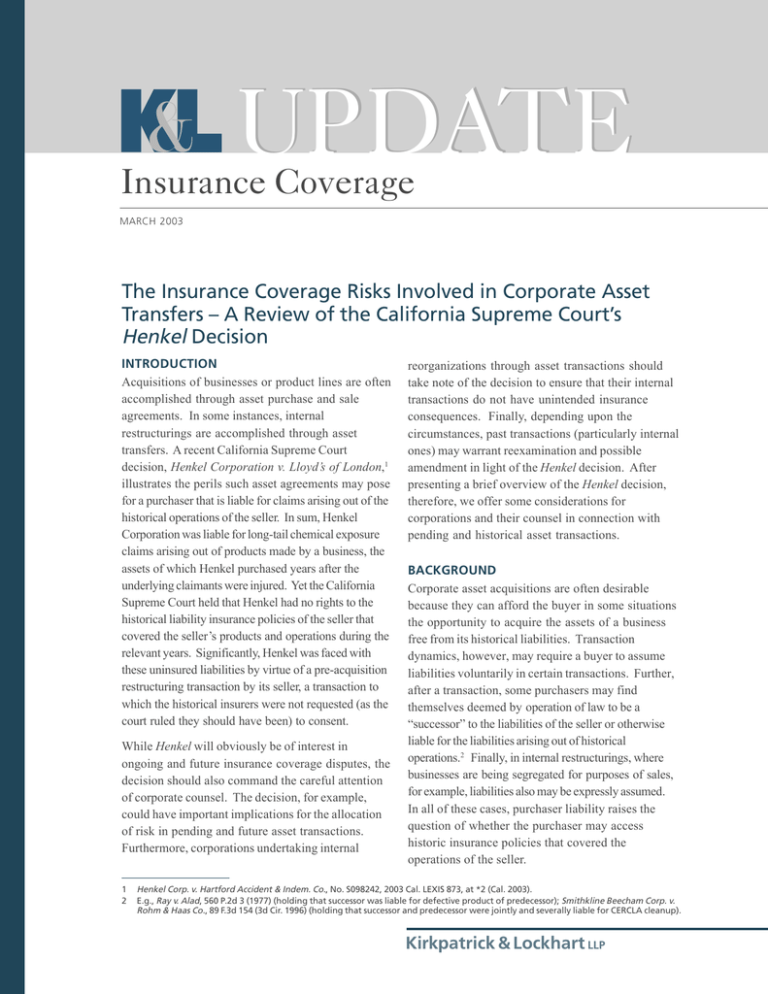
UPDATE
Insurance Coverage
MARCH 2003
The Insurance Coverage Risks Involved in Corporate Asset
Transfers – A Review of the California Supreme Court’s
Henkel Decision
INTRODUCTION
Acquisitions of businesses or product lines are often
accomplished through asset purchase and sale
agreements. In some instances, internal
restructurings are accomplished through asset
transfers. A recent California Supreme Court
decision, Henkel Corporation v. Lloyd’s of London,1
illustrates the perils such asset agreements may pose
for a purchaser that is liable for claims arising out of the
historical operations of the seller. In sum, Henkel
Corporation was liable for long-tail chemical exposure
claims arising out of products made by a business, the
assets of which Henkel purchased years after the
underlying claimants were injured. Yet the California
Supreme Court held that Henkel had no rights to the
historical liability insurance policies of the seller that
covered the seller’s products and operations during the
relevant years. Significantly, Henkel was faced with
these uninsured liabilities by virtue of a pre-acquisition
restructuring transaction by its seller, a transaction to
which the historical insurers were not requested (as the
court ruled they should have been) to consent.
While Henkel will obviously be of interest in
ongoing and future insurance coverage disputes, the
decision should also command the careful attention
of corporate counsel. The decision, for example,
could have important implications for the allocation
of risk in pending and future asset transactions.
Furthermore, corporations undertaking internal
1
2
reorganizations through asset transactions should
take note of the decision to ensure that their internal
transactions do not have unintended insurance
consequences. Finally, depending upon the
circumstances, past transactions (particularly internal
ones) may warrant reexamination and possible
amendment in light of the Henkel decision. After
presenting a brief overview of the Henkel decision,
therefore, we offer some considerations for
corporations and their counsel in connection with
pending and historical asset transactions.
BACKGROUND
Corporate asset acquisitions are often desirable
because they can afford the buyer in some situations
the opportunity to acquire the assets of a business
free from its historical liabilities. Transaction
dynamics, however, may require a buyer to assume
liabilities voluntarily in certain transactions. Further,
after a transaction, some purchasers may find
themselves deemed by operation of law to be a
“successor” to the liabilities of the seller or otherwise
liable for the liabilities arising out of historical
operations.2 Finally, in internal restructurings, where
businesses are being segregated for purposes of sales,
for example, liabilities also may be expressly assumed.
In all of these cases, purchaser liability raises the
question of whether the purchaser may access
historic insurance policies that covered the
operations of the seller.
Henkel Corp. v. Hartford Accident & Indem. Co., No. S098242, 2003 Cal. LEXIS 873, at *2 (Cal. 2003).
E.g., Ray v. Alad, 560 P.2d 3 (1977) (holding that successor was liable for defective product of predecessor); Smithkline Beecham Corp. v.
Rohm & Haas Co., 89 F.3d 154 (3d Cir. 1996) (holding that successor and predecessor were jointly and severally liable for CERCLA cleanup).
Kirkpatrick & Lockhart LLP
In Henkel, this question arose in the specific context
of liabilities assumed by contract (i.e., in an asset
purchase agreement), and the decision was expressly
limited to the context of a contractual assumption of
liabilities and transfer of assets. The case involved a
series of complicated transactions, but the relevant
one for the insurance coverage issue was the
contractual separation of two product lines of what
was then a wholly-owned subsidiary of Union
Carbide Corporation. Union Carbide acquired
Amchem Products, Inc., which manufactured and
sold agricultural and metallic chemicals, in 1979.
After Union Carbide acquired it in 1979, Amchem
Products, Inc., a Pennsylvania corporation
(“Amchem No. 1”), created a new Delaware
corporation of the same name (“Amchem No. 2”).3
Amchem No. 1 then transferred “all of its rights, title
and interest…in and to its domestic assets utilized in
its metalworking business” to Amchem No. 2.4 The
board of Amchem No. 2 unanimously accepted
Amchem No. 1’s transfer of “assets, liabilities and
goodwill utilized in its metalworking chemical
activities.”5 The Henkel court treated the 1979
resolutions as a contract between Amchem No. 1 and
No. 2. Henkel Corporation ultimately became the
successor to Amchem No. 2 by its 1980 acquisition of
all of Amchem No. 2’s stock and the subsequent
merger of the two entities. Amchem No. 1’s
successor was Rhone Poulenc, Inc., by virtue of its
purchase of the stock of Amchem No. 1 in 1986 and
the 1992 merger of Rhone Poulenc and Amchem
No. 1.6 These transactions set the stage for the
question of which entity or entities, Henkel, Rhone
Poulenc, or both, could claim the benefits of the
historical insurance assets of Amchem Products, Inc.
for liabilities arising out of the historical
metalworking chemical operations.
Claims arising out of those operations were asserted
in a suit brought in 1989 by current and former
Lockheed employees against Henkel and “Amchem
Products, Inc.” The Lockheed plaintiffs alleged
3
4
5
6
7
8
9
10
11
2
injuries arising out of exposure to metallic chemicals
between 1959-1976.7 The reference to “Amchem
Products, Inc.” did not make clear whether Amchem
No. 1 or Amchem No. 2 was the intended target of the
lawsuit, but the plaintiffs did not serve Rhone
Poulenc (i.e., the successor to Amchem No. 1) until
1992, some three years after they filed suit. Henkel
tendered its defense to the insurers that issued
policies to Amchem No. 1 during 1959-1976, as well as
to its own insurers. All denied coverage. After the
plaintiffs served Rhone Poulenc, it moved to quash
service. The plaintiffs ultimately agreed to Rhone
Poulenc’s motion, because they were presented with
documents that established that Henkel was
answerable for the metalworking chemical liabilities at
issue. Rhone Poulenc was therefore no longer a
defendant, and Henkel ultimately settled with the
Lockheed plaintiffs for $7.65 million in 1995 and sued
the insurers for declaratory relief.8
Because of Henkel’s merger with Amchem No. 2, the
trial court found that Henkel was responsible for all
of Amchem No. 2’s liabilities, including those assumed from
Amchem No. 1 in the 1979 asset acquisition.9 Henkel
contended that along with the liabilities, Amchem No.
2 also acquired assets, including insurance coverage
for the liabilities. The trial court disagreed, ruling
that any assignment of Amchem No. 1’s policies
would be void without the insurers’ consent and
entered summary judgment against Henkel.10
The court of appeal reversed, holding that the “right
to indemnity followed the liability rather than the
policy itself.” Therefore, because Amchem No. 2
acquired the liabilities of Amchem No. 1, it also
acquired the insurance policies covering such
liabilities. The decision was based, in part, upon
Northern Insurance Co. v. Allied Mutual Insurance
Co., which held that “even though the parties did not
assign [the predecessor insurance] policy in the
agreement, the right to indemnity under the policy
transferred to [the successor corporation] by
operation of law.”11
Henkel, 2003 Cal. LEXIS 873, at *3-4.
Id. at *4.
Id.
Id. at *5.
Id.
Id. at *6-7.
Id. at *7-8.
Id. at *8.
Id. at *8, (quoting Northern Insurance Co. v. Allied Mut. Ins. Co., 955 F.2d 1353, 1357 (9th Cir. 1993)).
KIRKPATRICK & LOCKHART LLP INSURANCE COVERAGE UPDATE
THE SUPREME COURT DECISION
The California Supreme Court characterized Henkel’s
principal arguments as follows: first, that insurance
coverage should follow liability when liability is
imposed by operation of law;12 and, second, that
policy benefits under occurrence policies may be
assigned without insurer consent once the events
giving rise to the liability have taken place.13 The
court rejected both arguments.
Was Liability Imposed by Law?
Turning to the first, the court outlined three
circumstances by which liability may be imposed on
an asset purchaser by operation of law. If Henkel’s
situation fell within any of the three categories, then
the question of whether or not insurance coverage
followed the liability as a matter of law would be
presented. The court did not reach this question,
however, because it found that liability was not
imposed by operation of law.
First, the court noted that an asset purchaser may be
subjected to liability under three broad criteria that
focus upon the transaction itself: (1) when the
transaction amounts to a consolidation or merger of the
two corporations; (2) when the purchasing corporation
is a mere continuation of the seller; or (3) when the
transfer of assets is for the fraudulent purpose of
escaping liability.14 Reviewing each prong of this test
briefly, the court found that none of these situations
applied to Henkel.
Second, the court noted that a company that acquires a
product line may be held liable as a matter of law for
injuries caused by its “predecessor’s” defective
products if the injured party has no remedies against
the original company.15 The court ruled this exception
inapplicable as well, because Rhone Poulenc, as the
successor to Amchem No. 1, could respond to any suit
based on pre-1979 toxic exposure. Further, it ruled that
12
13
14
15
16
17
18
19
20
21
22
23
even if Amchem No. 1 dissolved after the transfer of the
metallic division to Amchem No. 2, under California law
a plaintiff still could assert a claim against Amchem No.
1 for the purpose of accessing its liability policies.16
Third, the court noted some statutes, including
CERCLA,17 impose liability as a matter of law on
successor corporations without regard to contract. No
such statute existed with regard to the liabilities at issue
in the underlying suit. In sum, the court ruled that
Amchem No. 2 assumed the liabilities of Amchem No. 1
voluntarily by contract and was not subjected to the
imposition of the liabilities by operation of law.18
Because none of the criteria for imposition of liabilities
as a matter of law applied, the court did not address the
important question presented in such cases of whether
or not insurance rights also are transferred as a matter
of law to the deemed successor.19
Was Insurer Consent Required?
Having concluded that Amchem No. 2 assumed by
contract the historical liabilities at issue in the Lockheed
plaintiffs’ suit, the court ruled that Henkel’s rights, as
successor to Amchem No. 2, to any benefits under the
insurance policies “depend on the terms of the 1979
contract by which Amchem No. 2 acquired the assets of
Amchem No. 1.”20 Although ruling that the question
was a contractual one, the court did not address
whether or not the broad asset transfer language set
forth in the board resolutions that formed the basis of
the contract between Amchem No. 1 and Amchem No. 2
were intended to transfer insurance policy rights. It
reached this conclusion by ruling that any contractual
assignment “would be invalid because it lacked the
insurer’s consent.”21 The court held that a policy
provision purporting to prohibit “assignment of
interest” under the policy “without the insurer’s
consent endorsed on the policy”22 was effective to
preclude the assignment. In doing so, the court rejected
Henkel’s argument that insurer consent was
unnecessary for several reasons.23
Henkel, 2003 Cal. LEXIS 873, at *9.
Id. at *15.
Id. at *10.
Id. at *11.
Id. at *12.
Id. at *12; Comprehensive Environmental Response, Compensation, and Liability Act , 42 U.S.C. §9601, et seq. (2002).
Henkel, 2003 Cal. LEXIS 873, at *12.
Northern Insurance Co. v. Allied Mut. Ins. Co., 955 F.2d 1353, 1357-59 (9th Cir. 1993) (holding that a successor has the rights to a
predecessor’s policies, including a defense, after liabilities have been imposed by law).
Henkel, 2003 Cal. LEXIS 873, at *13.
Id. at *15.
Id.
Id. at *15-16.
MARCH 2003
Kirkpatrick & Lockhart LLP
Henkel initially argued that consent was not
necessary because the insurance rights were
transferred to it as a matter of law; as noted above,
the court rejected this argument. In addition, Henkel
argued that insurer consent was not necessary
because policy benefits under occurrence-based
policies may be assigned without consent after the
event giving rise to the liability has occurred. In
considering this argument, the court noted the
general principle that contractual and legal
prohibitions on assignment do not preclude the
assignment of money due or to become due under a
contract or assignment of claims for breach thereof.
The court ruled, however, that even if the general
principle applied to liability insurance policies, it did
not apply to the circumstances of the Henkel case.
In rejecting Henkel’s argument, the court reasoned
that Amchem No. 2 assumed Amchem No. 1’s
liabilities before the duty to defend and indemnify
the claims of the Lockheed plaintiffs became an
assignable chose in action. The claims had not been
reduced to a sum of money due, and the court
reasoned that there was not a wrongful failure to
defend or indemnify the Lockheed plaintiffs’ claims
prior to the 1979 transaction, because the claims had
not yet been asserted. Thus, the court ruled that the
right to defense and indemnity for the Lockheed
plaintiffs’ claim could not be assigned without the
insurers’ consent.
Henkel also argued that assignment of the policies,
even without insurer consent, would not place an
additional risk on the insurers. Since the claims
involved the risks contemplated by the insurers upon
the issuance of the policies, Henkel contended that
the assignment would not affect either the liability of
the insurers, or the policy limits. The court
disagreed, stating that an additional burden might
arise if the predecessor corporation still existed or
could be sued. In such cases, the court argued that
an insurer might be faced with the costly task of
defending both the predecessor and successor
24
25
26
27
28
29
30
31
4
corporations.24 Further, the court suggested that the
mere dispute over which party was covered may also
create an additional burden for the insured. Because
of these perceived additional burdens, the court
rejected the argument that consent was not
necessary. 25
The Dissent
The Henkel ruling provoked a spirited dissent, albeit
by a single justice. According to the dissent, the
majority failed to recognize and follow California case
law that permits the assignment of insurance
coverage after a loss has occurred.26 Further, the
dissent argued that the majority mischaracterized the
nature of a chose in action. According to the
California Civil Code, a chose in action is defined as
“a right to recover money or other personal property
by a judicial proceeding.”27 The dissent reasoned
that a chose in action is not, as the majority stated, a
claim reduced to a monetary judgment.
Further, the dissent disagreed with the majority’s
contention that an assignment of the policy resulted
in greater liability for the insurer. To the contrary, “an
insurer’s risk cannot be increased by a change in the
insured’s identity.”28 Because liability is fixed (in an
occurrence policy) when the event giving rise to the
injury occurs, an assignment of the policy to another
entity after the event cannot give rise to greater
liability.29 Quoting Northern Insurance, the dissent
stated: “[w]hen the loss occurs before the transfer,
however, the characteristics of the successor are of
little importance: regardless of any transfer, the
insurer still covers only the risk it evaluated when it
wrote the policy.”30 Under the dissent’s view,
liability could not, as the majority contended, be
increased if the predecessor still existed, because any
right to the policy would have been transferred to the
successor.
IMPLICATIONS OF THE HENKEL DECISION
Henkel has a number of important implications for
transactions involving asset acquisitions. 31
Id. at *18.
Id. at *19.
Id. at *22.
Id. at *25-26, (quoting Cal. Civ. Code § 953 (2003)).
Id. at *30.
Id. at *27.
Id. at *31-32, citations omitted.
Of course, as with any transaction, the particular circumstances of the deal may render some or all of these suggestions inapplicable.
Furthermore, other aspects of the transaction may outweigh consideration of these insurance issues.
KIRKPATRICK & LOCKHART LLP INSURANCE COVERAGE UPDATE
■
If deal dynamics require the assumption of a seller’s
liabilities, there is no clear path (if Henkel applies) for
the buyer clearly to acquire the seller’s insurance
rights without insurer consent. There may, however,
be creative ways to increase the possibility that a
buyer would obtain the benefit of historical
insurance assets. One such possibility may include
a transaction under which: (i) the buyer assumes the
seller’s uninsured liabilities; (ii) the buyer agrees to
advance funds for insured liabilities; (iii) the buyer’s
advancement of funds for the insured liabilities
would be subject to a right to recover from the seller
any insurance coverage proceeds the seller obtains
from its historical insurers; and (iv) the buyer agrees
to fund, and has the right to control, the pursuit of
that historical insurance coverage.
■
Purchasers of a business, even where stock is being
acquired, should perform careful due diligence
regarding prior internal transactions to determine
whether (as in Henkel) a corporation being
purchased had earlier assumed liabilities for which
historical insurance assets may not be available.
■
Corporations should consider carefully the
insurance implications of internal restructurings
Boston
Dallas
Harrisburg
Los Angeles
Miami
Newark
New York
Pittsburgh
San Francisco
Washington
John M. Edwards
Robert Everett Wolin
Raymond P. Pepe
David P. Schack
DanielA. Casey
Anthony P. La Rocco
Peter J. Kalis
Peter J. Kalis
Edward P. Sangster
Matthew L. Jacobs
617.261.3123 jedwards@kl.com
214.939.4909 rwolin@kl.com
717.231.5988 rpepe@kl.com
310.552.5061 dschack@kl.com
305.539.3324 dcasey@kl.com
973.848.4014 alarocco@kl.com
212.536.4828 pkalis@kl.com
412.355.6562 pkalis@kl.com
415.249.1028 esangster@kl.com
202.778.9393 mjacobs@kl.com
■
A review of historical transactions that may have
negative insurance implications for the purpose of
potential corrective amendments may be in order.
■
Finally, corporations should not assume that the
rule articulated in Henkel will necessarily apply
outside of California. Courts have taken
conflicting approaches to the issue in Henkel and
to related disputes regarding a successor’s rights
to the insurance coverage of a predecessor.32
A corporation’s perspective on Henkel in insurance
coverage disputes will obviously vary depending
upon whether it retained insurance rights or whether
it may find itself without insurance rights it believed
it possessed. For pending and future transactions,
however, the decision clearly suggests that the asset
buyer who assumes historical liabilities should
carefully consider how best to reduce the risk of not
acquiriing the benefits of the corresponding historical
insurance policies.
DAVID F. MC GONIGLE
dmcgonigle@kl.com
412.355.6233
The Insurance Coverage practice group at Kirkpatrick &
Lockhart LLP is one of the nation’s largest policyholderoriented practices. Its attorneys have authored Policyholder’s
Guide to the Law of Insurance Coverage and currently edit
the Journal of Insurance Coverage.
FOR ADDITIONAL INFORMATION about these issues,
please consult any of Kirkpatrick & Lockhart’s office
contacts listed below:
that could result in the assumption of liabilities
but not the transfer of insurance rights.
MEGHAN L. DAUGHERTY
mdaugherty@kl.com
412.355.8925
32 D.F. McGonigle, “Long-Tail Successor Liability and the Right to
Access a Predecessor’s Insurance Coverage: Conflicting Responses
from California Courts,” J. of Ins. Coverage, Vol. 4, No. 4, 71, 77
(Autumn 2001). The article refers to Gopher Oil Co. v. Amer.
Hardware Mut. Ins. Co., 588 N.W.2d 756 (Minn. Ct. App. 1999)
which holds that a successor is entitled to coverage under a
predecessor’s policy. However, the article also makes reference
to Red Arrow Products Co., Inc. v. Employers Ins. of Wausau, 607
N.W.2d 294 (Wis. Ct. App. 2000) in which the court denies
coverage to the successor because they were neither a party to
the original insurance contract, nor an assignee of the policy.
See also B.S.B. Diversified Co., Inc. v. Am. Motorists Ins. Co. ,
947 F. Supp. 1476, 1482 (W.D. Wash. 1996) (holding that a
contractual sale of assets is an effective transfer of both
liabilities and insurance coverage).
®
Kirkpatrick & Lockhart LLP
Challenge us. ®
www.kl.com
BOSTON
■
DALLAS
■
HARRISBURG
■
LOS ANGELES
■
MIAMI
■
NEWARK
■
NEW YORK
■
PITTSBURGH
■
SAN FRANCISCO
■
WASHINGTON
.........................................................................................................................................................
This publication/newsletter is for informational purposes and does not contain or convey legal advice. The information herein
should not be used or relied upon in regard to any particular facts or circumstances without first consulting a lawyer.
© 2003 KIRKPATRICK & LOCKHART LLP.
ALL RIGHTS RESERVED.

